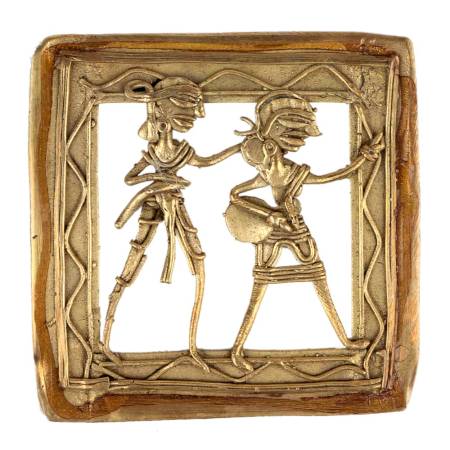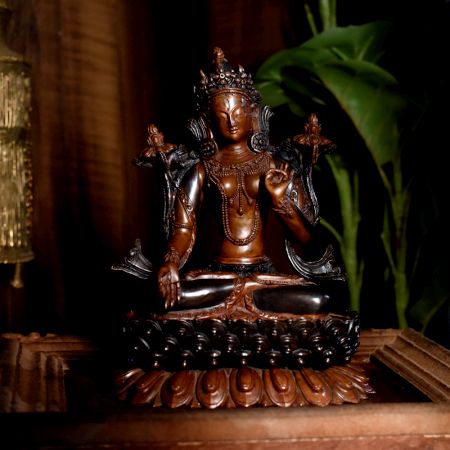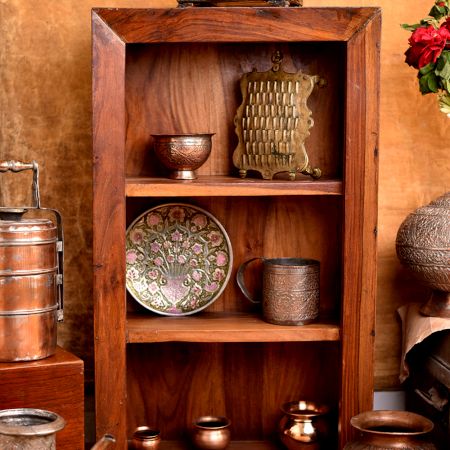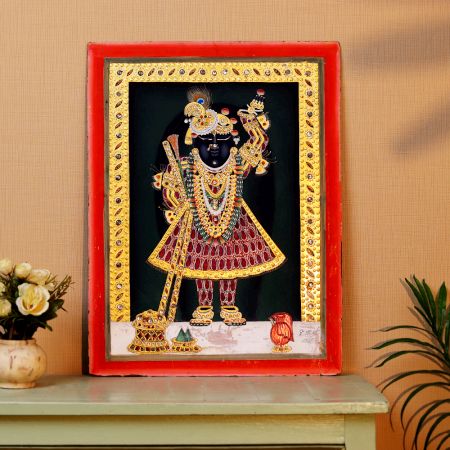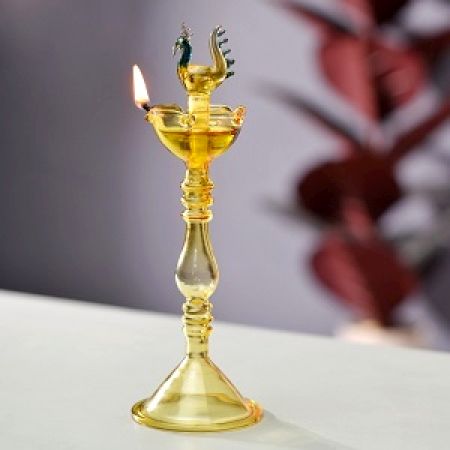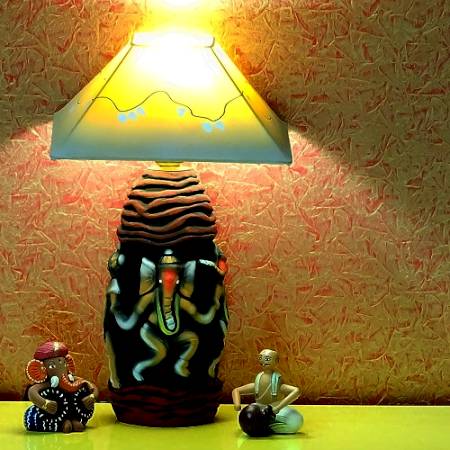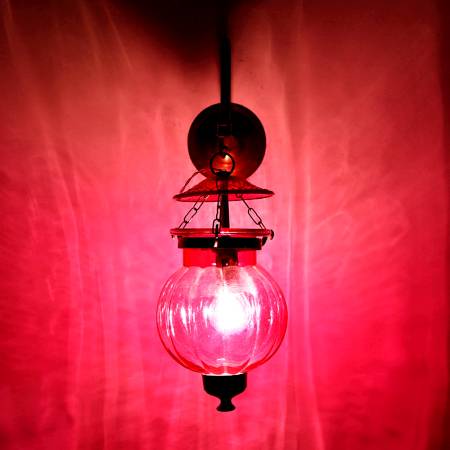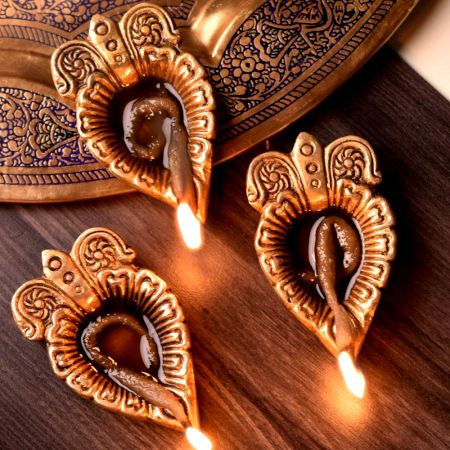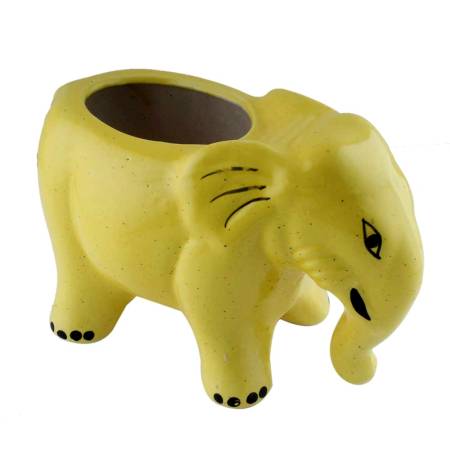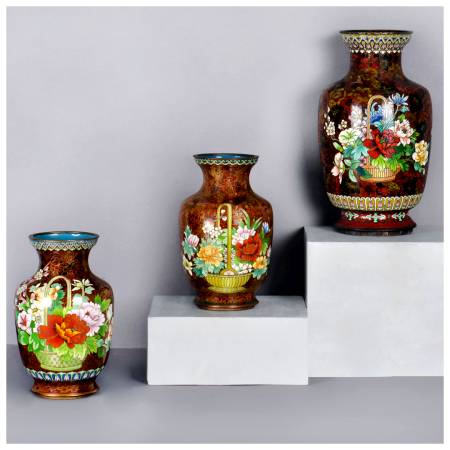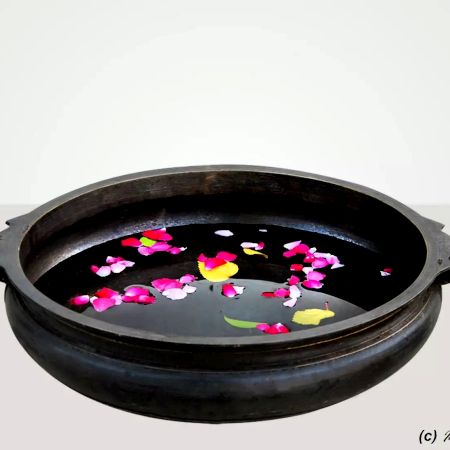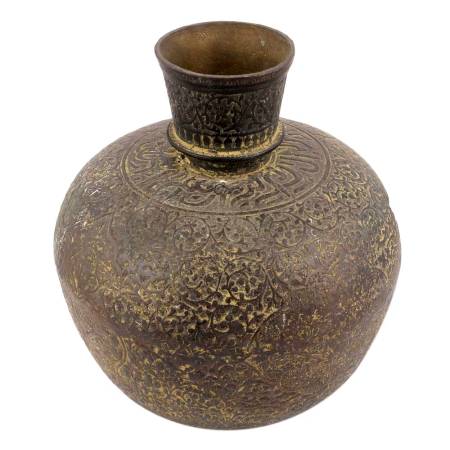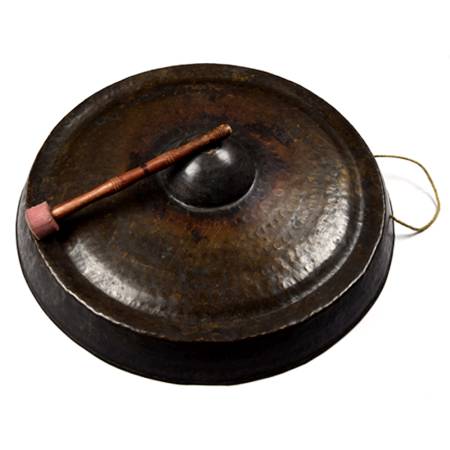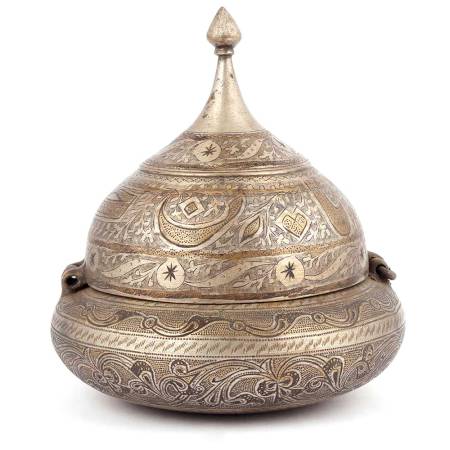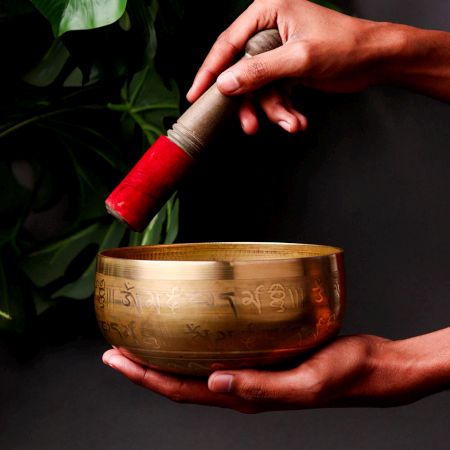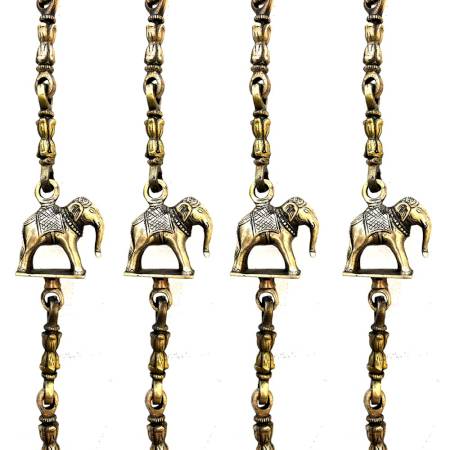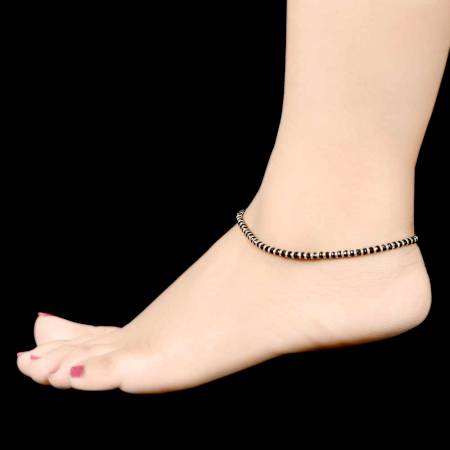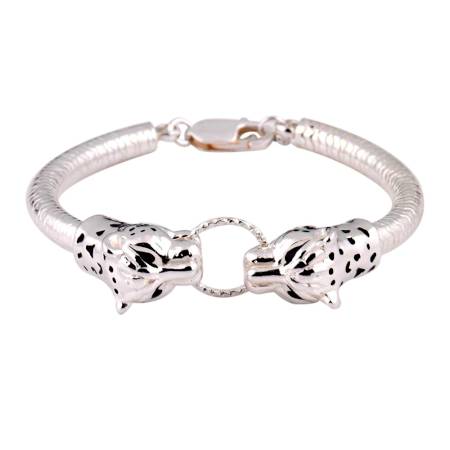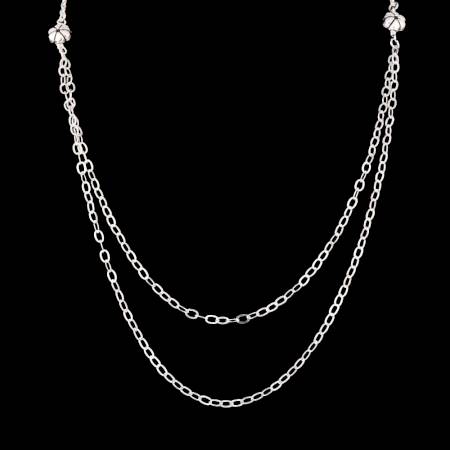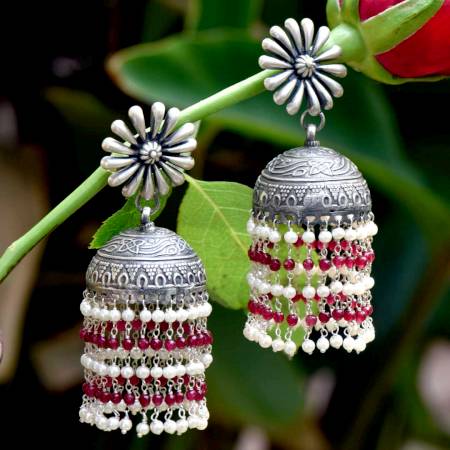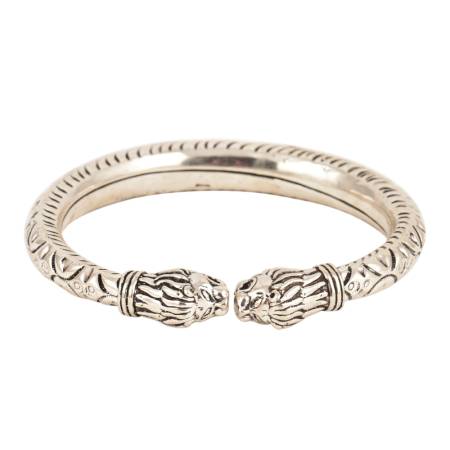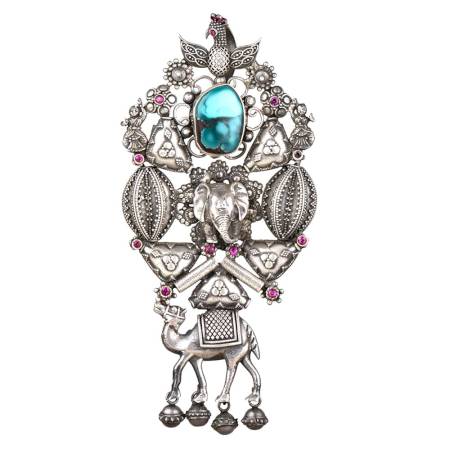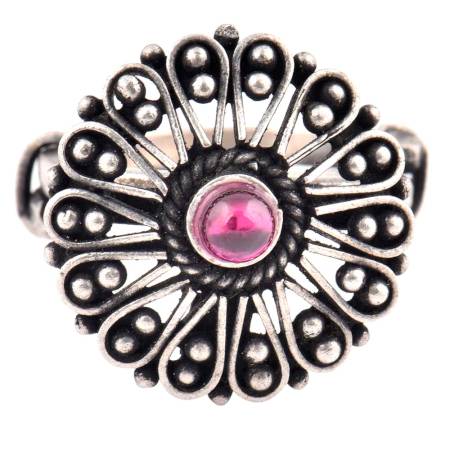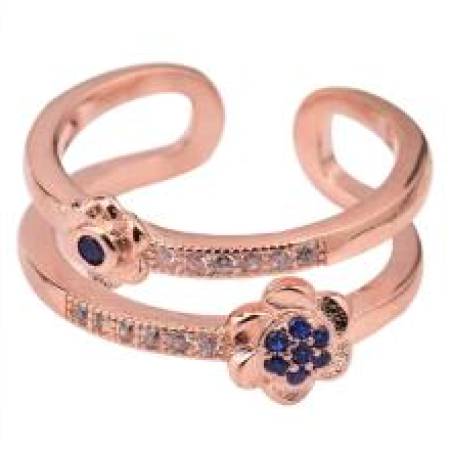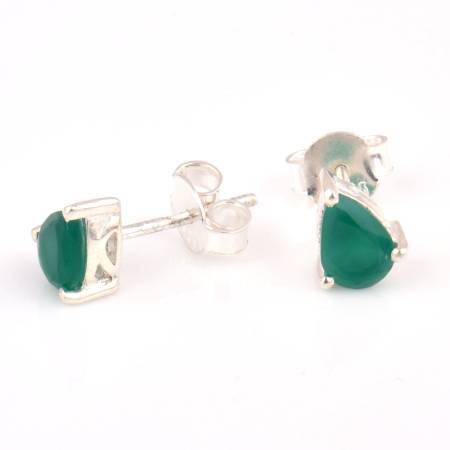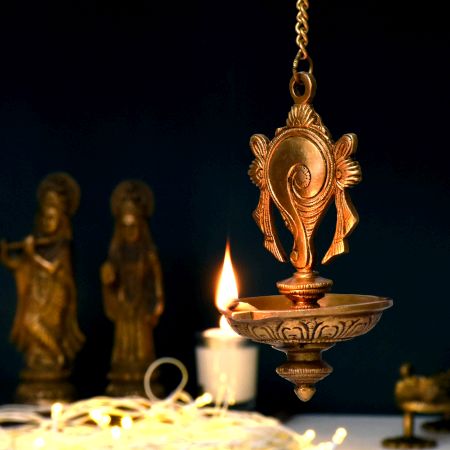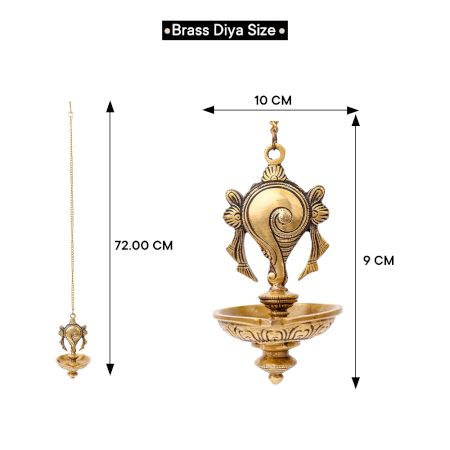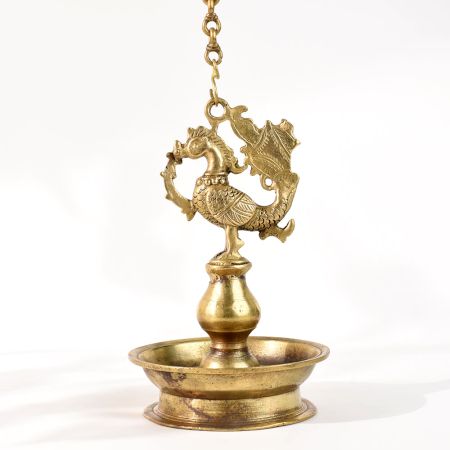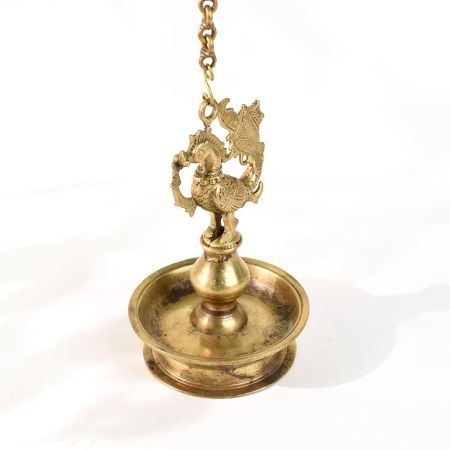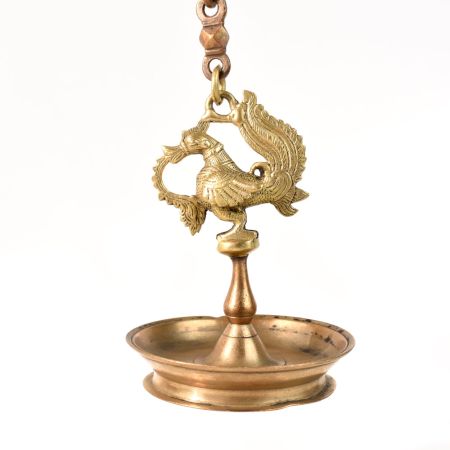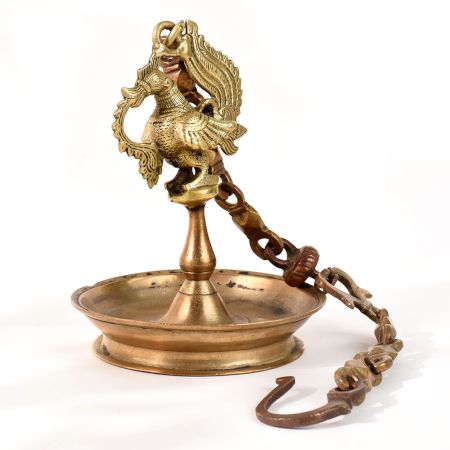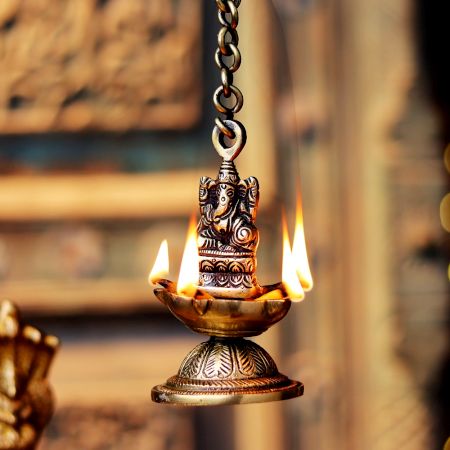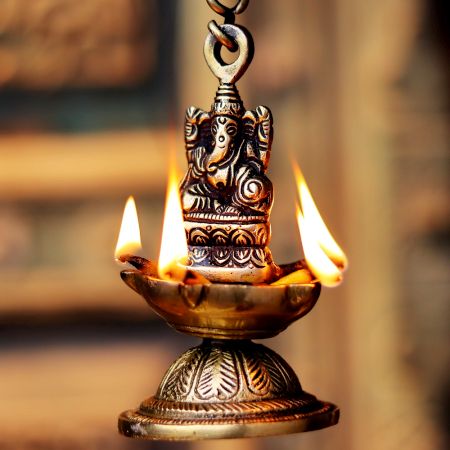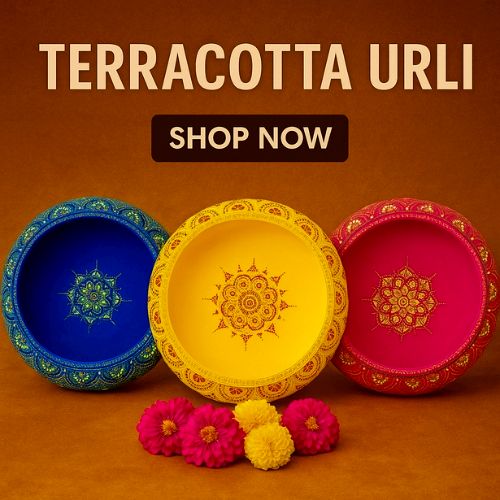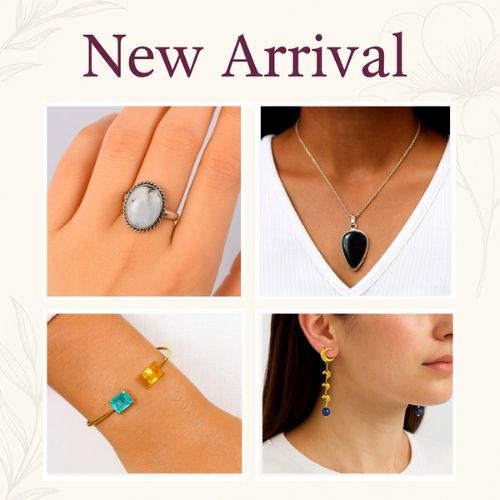-
Handmade Golden Brass Hanging Diya Home Temple Pooja Room With Chain
-
₹ 2,061.50
₹ 2,170.00 -
Only a few left
-
₹ 2,061.50
Thooku Vilakku: An Emblem of Tradition and Elegance
The Thooku Vilakku, the hanging lamp of South India, is not just a crafted object but a suspended memory of light. It lingers between earth and sky, between tradition and present life, offering more than illumination. To stand beneath it is to feel anchored yet uplifted, as if time itself rests in its sway. Its polished brass body holds fire in silence, whispering devotion into daily rhythm. It is not decoration alone, but a reminder of continuity, of rituals carried, of stories preserved, of faith made visible in the tender dance of flame.
What Is a Thooku Vilakku?
A Thooku Vilakku is a hanging oil lamp, traditionally suspended from ceilings in homes, courtyards, and temples. Beyond being a source of light, it functions as a sacred vessel, designed to connect ritual with atmosphere. Its presence creates a rhythm where light descends gently, blessing the space beneath it. The lamp is usually crafted in brass or bronze and held aloft by chains, offering both endurance and grace. More than an object, it is a threshold between the physical and the spiritual, ensuring that devotion is not simply practiced but lived. Its flame becomes a living prayer, a gesture of protection, and an emblem of purity.
What Emotions or Symbolism Does a Thooku Vilakku Commonly Represent?
The Thooku Vilakku carries emotions of reverence, trust, and serenity. Its hanging form suggests surrender, of letting light fall where it chooses, without interference. Symbolically, it represents balance, continuity, and the bridge between divine and human. In temples, it embodies sanctity and timelessness, in homes, it becomes an intimate reminder of warmth, protection, and blessings. The flame is not just fire, it is presence, awareness, and the gentle assurance of guidance. To watch its shadows ripple across walls is to witness life in motion, both fragile and eternal. Its symbolism extends to hope, to the endurance of values, and to the quiet power of ritual.
What Are the Most Recognized Styles and Regional Variations of Thooku Vilakku?
Regional styles of Thooku Vilakku reveal subtle shifts in craft and culture. In Kerala, the lamp often embraces minimal design, emphasizing pure brass sheen and clarity of form. Tamil Nadu versions are more ornate, sometimes featuring motifs of deities, peacocks, or floral engravings. In Karnataka, the design may integrate more functional chains, balancing utility with grace. Each region carries its history in the lamp’s body, whether simple, elongated, or richly sculpted. These variations reflect not only artistic choices but also the spiritual sensibilities of each community, where devotion and design are inseparably woven into daily life.
Why Is the Thooku Vilakku Still Revered in Contemporary Homes and Temples?
The reverence for Thooku Vilakku persists because it transcends utility, it embodies continuity. Even in modern interiors, where lightbulbs dominate, the presence of a hanging lamp marks a connection to ancestry and ritual. In temples, it continues to define the sanctified atmosphere, its glow forming the first and last sight of a devotee’s visit. In homes, it becomes a gesture of auspiciousness, a way of rooting modern life in the soil of tradition. Its timelessness lies in its symbolism, that light is not optional but essential, not merely functional but sacred. To hang a Thooku Vilakku is to preserve memory and to invoke blessing.
Craftsmanship, Materials & Artistic Tools for Thooku Vilakku
Crafting a Thooku Vilakku is an act of patience and devotion. It begins with the metal itself, chosen not only for endurance but for its ability to carry polish, shine, and resonance. Artisans work through melting, shaping, and chiseling, transforming raw material into an object that feels alive. Every curve, every chain link, every hook is more than hardware, it is ritualized skill, tested across generations. Tools may be simple, but the hand that wields them carries tradition. To touch a Thooku Vilakku is to feel more than metal, it is to sense human intention poured into form.
How Were Thooku Vilakkus Traditionally Crafted by Artisans?
Traditional crafting of Thooku Vilakku followed processes inherited across generations of metalworkers. Brass or bronze was melted and cast into forms, often using molds designed to capture precision and proportion. After cooling, surfaces were smoothed, polished, and detailed with chisels. Chains and hooks were forged separately, tested for strength and balance, then joined to ensure secure suspension. Beyond mechanics, artisans imbued the lamp with symbolic alignment, curves echoing continuity, engravings representing divine presence. These lamps were not mass produced but born of hands that shaped every contour deliberately. Each lamp thus carried not only fire but also the unseen devotion of its maker, blending skill with spirituality.
What Metals and Alloys Were Commonly Used?
Brass and bronze formed the foundation of most Thooku Vilakkus. Brass, with its bright golden sheen, symbolized purity and was believed to attract positive energy into the home or temple. Bronze, heavier and darker, carried durability and resistance, making it ideal for temple use where lamps burned for long hours. Copper, though less common, sometimes found its way into the alloy, deepening tone and texture. The choice of metal was never accidental, it reflected the intended purpose of the lamp. The warmth of brass invited domestic harmony, while the resilience of bronze spoke of endurance. Each alloy, through shine and weight, translated devotion into tangible form.
What Role Do Chains, Hooks, and Hanging Mechanisms Play in the Design of a Thooku Vilakku?
Chains and hooks in a Thooku Vilakku are more than practical, they are essential to its meaning. The chain determines the lamp’s position, dictating how far light falls, how shadows stretch, and how presence is felt in a room or temple. Its links represent continuity, each joining the next, echoing the cycle of time. Hooks, meanwhile, ensure stability, making the lamp both secure and graceful in suspension. Together, they create a balance of strength and delicacy. Without them, the lamp is incomplete, with them, it hovers like a blessing in air, transforming fire into an experience of depth and stillness.
Ritual, Symbolism and Storytelling of Thooku Vilakku
The Thooku Vilakku is not merely lit, it is awakened. Its ritual goes beyond flame and oil, it is a narrative of offering, of opening the day with prayer and closing it with gratitude. In temples, its light becomes the collective breath of devotion, in homes, it becomes a guardian against darkness. Its shadows tell stories, its glow invites reflection. It represents not just illumination but storytelling, carrying centuries of whispered myths, chants, and blessings. The Thooku Vilakku is never only an object, it is both the beginning and the echo of devotion.
What Spiritual Stories or Messages Does a Thooku Vilakku Aim to Convey?
At its heart, the Thooku Vilakku conveys the message of light triumphing over darkness. It embodies purity, the eternal flame of knowledge, and the continuity of prayer. Stories often link its flame with divine presence, Lakshmi’s prosperity, Saraswati’s wisdom, or Shiva’s cosmic dance illuminated. The lamp whispers that life is fragile yet luminous, temporary yet eternal. Its position, suspended yet grounded, teaches balance, reminding us that while we belong to earth, our spirits must look upward. The oil, the wick, the flame, each tells of offering, sacrifice, and renewal. In this way, the lamp is not decoration but scripture written in light.
How Do Temples and Homes Use Thooku Vilakkus to Express Devotion, Culture, and Auspiciousness?
Temples place Thooku Vilakkus at entrances, sanctums, and pathways, where their glow sanctifies every step of the devotee. The lamp’s light signals not just illumination but welcome, a gesture of divine hospitality. In homes, it is often lit during prayers, festivals, or auspicious beginnings. Its presence at thresholds marks prosperity entering, misfortune leaving. Beyond function, it expresses continuity of culture, where lighting a lamp is not just act but inheritance. Each flame becomes a dialogue between ancestors and descendants, faith and practice. The Thooku Vilakku thus integrates devotion with identity, ensuring rituals are not forgotten but renewed daily.
How Do Light, Flame, and Shadows from the Thooku Vilakku Influence the Mood of a Space?
The light of a Thooku Vilakku alters space by introducing warmth and depth. Its flame flickers softly, creating a rhythm that feels alive, making still rooms breathe. Shadows stretch across walls, turning blank surfaces into moving canvases, filling them with texture and mystery. In temples, this play of light deepens the sacred atmosphere, pulling the mind toward contemplation. In homes, it softens the evening, creating intimacy, safety, and calm. The flame soothes, while the shadows remind of impermanence, together, they make space both grounding and ethereal. A room lit by Thooku Vilakku does not just shine, it speaks, whispers, and remembers.
Purchase, Collection & Investment of Thooku Vilakku
The Thooku Vilakku is more than a lamp; it is a suspended memory glowing with history, prayer, and heritage. To purchase it is to buy not just brass, but the hush of dawn, the warmth of devotion, the murmur of ancestors who lit the same flame. A collection of such lamps becomes a museum of continuity in a private home, where each wick burns like an echo of the past. As an investment, it is not bound by markets or numbers. It grows in value when someone pauses before its glow and remembers where light first began.
Where Can You Buy Authentic or Antique Thooku Vilakkus?
Authentic or antique Thooku Vilakkus are most often found in traditional craft markets of Kerala and Tamil Nadu, where artisans still forge brass with inherited skill. Beyond local bazaars, curated heritage stores and online platforms dedicated to Indian handicrafts preserve the integrity of such lamps. Temples that replace old lamps during restoration often release them into auctions, allowing seekers to claim a piece of spiritual legacy. Buying from antique dealers demands caution, but it opens the possibility of finding rare pieces with inscriptions or temple markings. When purchased directly from artisans, the lamp carries freshness of craft, when acquired as antique, it carries the patina of time. Both paths meet in reverence. The buyer must decide whether they seek the hand of the living craftsman or the touch of history.
How Can You Verify the Authenticity of a Handcrafted or Vintage Thooku Vilakku?
Verification begins with the metal itself. Pure brass has a certain density and sound when tapped, unlike modern alloys. Authentic handcrafted Thooku Vilakkus reveal subtle imperfections, where the artisan’s hand has left tiny variations, not the mechanical precision of machines. Vintage pieces often bear marks of use: darkened interiors where oil has long burned, softened edges polished by years of touch, and a mellow golden tone instead of bright glare. Provenance also matters; reliable sellers often provide history or temple origin. If buying through auctions or antique shops, requesting documentation of age helps ensure integrity. Yet authenticity is also sensed, not just proven. When a lamp feels alive, its surface telling stories of ritual smoke, its chains worn from repeated hanging, it carries the assurance of truth. A true Thooku Vilakku is less about flawless finish, more about the aura of time it refuses to hide.
What Makes a Thooku Vilakku a Worthwhile Cultural and Spiritual Investment?
A Thooku Vilakku is worthwhile because it bridges three dimensions, cultural, spiritual, and emotional. Culturally, it sustains a lineage of South Indian ritual practices, ensuring the lamp’s survival as more than a decorative object. Spiritually, it symbolizes illumination over darkness, a daily act of lighting that aligns household rhythm with cosmic rhythm. Emotionally, it gathers memory, every evening flame is linked to prayers once whispered by earlier generations. Unlike material assets, its value does not erode with wear. A tarnished lamp can glow anew, and even when unused, it remains a relic of faith. It is an investment in heritage that outlasts transient markets. The worth lies not in resale but in resonance, the moment someone lights the lamp and feels continuity with ancestors, community, and the eternal cycle of flame and shadow. That is the return no currency can measure.
Care, Polishing & Preservation of Thooku Vilakku
The lamp’s glow is eternal, but its body demands care. A Thooku Vilakku responds to touch and attention. The brass breathes better when polished, the chain shines when freed from dust, and the flame brightens when the right oil is poured. To care for it is to converse with it: washing gently, rubbing softly with natural powders, never stripping away the patina that time has gifted. Preservation is not just about keeping it new, but about allowing it to age with dignity. A cared-for lamp carries the scent of oil, the warmth of fingers, the rhythm of daily devotion.
How Do You Properly Clean and Maintain a Thooku Vilakku?
Cleaning begins with respect, not haste. Brass responds well to natural methods, tamarind paste, lemon with salt, or a soft mixture of gram flour with water. These not only remove stains but preserve the softness of its golden glow. After cleansing, the lamp should be dried completely, as lingering moisture tarnishes brass. Maintenance involves not over-polishing; too much scrubbing erases the character of age. Hanging chains should be checked to ensure their strength, avoiding accidents. Weekly oiling of the lamp’s interior helps prevent corrosion. Most importantly, it should be handled often, left untouched, a lamp grows dull both in spirit and surface. When cleaned as part of ritual, care itself becomes worship, and the lamp glows with a vitality beyond mere shine.
What Types of Oils, Wicks, and Materials Best Suit Its Illumination?
Tradition prefers sesame oil or ghee, as both release a steady flame and gentle fragrance. Sesame oil produces a clear, enduring glow, while ghee lends warmth and sacredness. Cotton wicks, twisted finely, are ideal. The thickness of the wick controls flame size. Using multiple wicks symbolizes abundance, while a single wick suits meditative prayer. Brass, the chosen metal, conducts heat well and endures the constant presence of oil without decay. Some families experiment with coconut oil, though it tends to darken the lamp faster. Ultimately, the choice of oil and wick reflects intention, whether to invite prosperity, create calm, or simply honor tradition. Each combination carries not just physical light but emotional meaning, shaping how the flame dances and how the room receives its energy. The materials must suit not only the lamp but the heart of the person lighting it.
Can Old or Damaged Thooku Vilakkus Be Restored Without Losing Their Original Charm?
Yes, old Thooku Vilakkus can be restored, but with restraint. Minor dents and tarnish should be preserved as marks of time rather than erased completely. Skilled artisans can reforge broken chains, realign bent holders, and reinforce weakened metal while retaining the lamp’s original shape. Over-polishing or chemical treatments, however, risk stripping away its soul. The charm lies in patina, the darkening of brass, the soft polish from countless touches, the uneven glow of age. Restoration should aim at making it usable and safe without forcing it to look new. In fact, families often prefer to leave old lamps partially worn, treating every scar as part of its story. True restoration is less about repair and more about continuation, allowing an old lamp to shine again while keeping alive the memory of every flame it has carried across decades.
What Are Common Issues Thooku Vilakkus Face Over Time?
Over time, Thooku Vilakkus face natural wear, tarnishing of brass, loosening of chains, or residue build-up from oils. Frequent use may lead to soot stains that darken the surface, while long neglect results in corrosion spots. Chains that hold the lamp can weaken and require careful inspection to prevent accidents. In coastal climates, humidity accelerates tarnish. Old lamps may also lose balance if parts warp, affecting even flame distribution. Yet these issues are not signs of weakness, they are simply the language of time on metal. With care, each problem can be managed, and the lamp can continue to glow for generations. Such aging is not decay but transformation, a reminder that even light-bearing objects carry shadows of endurance.
Home Decor, Styling & Mood Setting With Thooku Vilakku
In modern spaces, the Thooku Vilakku stands as both heritage and mood-setter. Its hanging form captures eyes upward, where flame dances mid-air, freeing light from corners and scattering it across walls. In a puja room, it becomes the still center; in a verandah, it glows like a sentinel; in a living room, it turns ordinary evenings into timeless gatherings. Styling it requires balance, surrounding décor must complement without overshadowing. As home décor, it is not just ornament, it is atmosphere. As mood, it is not just light, it is presence. A Thooku Vilakku transforms rooms into sanctuaries.
How Can Thooku Vilakkus Influence a Room’s Ambience or Spiritual Energy?
A Thooku Vilakku influences ambience through light and symbolism. The brass surface reflects a warm golden aura, while the flame’s steady rhythm calms the mind and anchors attention. Spiritually, it is believed to dispel negativity, replacing shadows with clarity. In a quiet room, the lamp’s glow can feel like a breathing presence, steady yet alive. In gatherings, it softens the mood, making spaces intimate and welcoming. The act of lighting itself adds ritual, a pause in the day when silence enters. Unlike electric light, it carries soul; unlike candles, it carries tradition. Its presence elevates a space beyond decoration, inviting reflection, prayer, or simply a deep quietness that feels like belonging.
What Interior Styles Pair Well With Hanging Brass Lamps?
Thooku Vilakkus pair seamlessly with traditional South Indian interiors where wood, brass, and handwoven fabrics dominate. Yet they also enrich contemporary minimalist spaces. Suspended against plain white walls, their golden light becomes sculptural art. In rustic homes, they add depth, resonating with stone, terracotta, and earthy tones. In eclectic styles, they serve as cultural anchors amid modern furnishings. Even industrial settings benefit, the raw glow of brass contrasts steel and concrete, softening hardness with warmth. The key is not matching but balancing. The lamp should appear as a natural extension of the room’s spirit. Whether placed among carved furniture or sleek glass tables, it bridges old and new, reminding every interior that light has always been the first form of decoration.
How Do You Choose the Right Thooku Vilakku for a Living Room, Puja Room, or Verandah?
Choice depends on purpose. For a puja room, smaller lamps with multiple wicks suit rituals, as they concentrate light within the sacred space. In living rooms, medium-sized lamps hung slightly lower invite intimacy, encouraging guests to gather near its glow. For verandahs, larger and sturdier lamps are best, they withstand breeze and act as guiding lights from outside. Design also matters: simple forms for prayer spaces, ornate carvings for display areas, elongated lamps for tall verandahs. Placement height influences mood, the higher it hangs, the more ethereal the light, the lower it rests, the more personal it feels. Ultimately, the right lamp is chosen not just by size or design, but by intent, whether to worship, welcome, or witness.
Cultural Impact & Historical Legacy of Thooku Vilakku
The Thooku Vilakku, the hanging oil lamp, carries the essence of continuity. It is not only a vessel of light but a suspended bridge between faith and daily life. In temples, it frames the sanctum with a halo that glows above the devotee’s head. In households, it hangs silently as a custodian of memory, its chain a thread binding generations. The act of lighting it transforms space, turning an ordinary corner into an altar. Its legacy is not written in scriptures alone but in the shadows it has cast on walls for centuries, whispering of devotion and belonging.
What Is the Historical Significance of Thooku Vilakku in South Indian Temples and Households?
The historical significance of the Thooku Vilakku lies in its role as a perpetual reminder of presence, divine and ancestral. In South Indian temples, these lamps were not placed on the ground but suspended, marking purity and reverence. They were believed to guide the gods’ gaze downwards, illuminating rituals and chants. In households, their light created a sacred perimeter around domestic life, protecting and sanctifying everyday activities. Over centuries, families hung these lamps in courtyards and verandas, embedding them into architecture itself. Their glow became part of seasonal rhythms, festival nights, and dawn prayers, making the Thooku Vilakku both an object and an atmosphere of continuity.
How Did Different Dynasties and Regions Shape the Evolution of the Thooku Vilakku?
Dynasties shaped the Thooku Vilakku not merely by patronage but through craft and design. The Cholas refined them with bronze artistry, embedding motifs of lotus and peacock. The Nayaks added grandeur with elongated chains and ornamental carvings. The Travancore rulers emphasized simplicity, letting function blend with faith. Regions shaped details, Kerala lamps carried organic curves echoing coconut palms, Tamil Nadu lamps bore sharp geometric motifs, while Karnataka saw sturdy brass forms meant for longevity. Each adaptation mirrored the cultural ethos of its land. Through dynasties and regions, the Thooku Vilakku evolved into a composite symbol, part ritual, part art, part inheritance.
Which Communities and Traditions Have Preserved the Legacy of Hanging Oil Lamps?
The legacy of the Thooku Vilakku endures because of communities that see continuity as devotion. In Kerala, Namboodiri households and temples preserve it as a daily ritual. In Tamil Nadu, Shaivite and Vaishnavite traditions light them during pujas, festivals, and ceremonies. Christian homes in Kerala too adopted the lamp, hanging it during Christmas or family prayers, blending faiths through flame. Artisans in Tamil Nadu and Kerala continue their craft, passing skills from father to son, preserving the chain of making as much as the lamp itself. These communities ensure that the Thooku Vilakku is not a museum relic but a living, glowing practice.
Thooku Vilakku vs Other Lamps
The Thooku Vilakku is distinct because of its suspension. Unlike lamps rooted to ground or table, its presence is lifted, floating, and unbound. Nilavilakku rises from the earth with dignity. Kuthu Vilakku stands tall in rituals. But the hanging lamp holds a different poetry. It sways with air, catches light at angles, and creates circles of illumination that shift. Against modern electric lamps, it carries silence and slowness, reminding of an era when light was prayer. Its uniqueness lies not in competition but in offering a different rhythm of light, one where every flame feels suspended between heaven and earth.
How Is the Thooku Vilakku Different From Nilavilakku or Kuthu Vilakku?
The Thooku Vilakku differs in placement and presence. The Nilavilakku, a floor-standing lamp, is anchored and upright, demanding respect in rituals. The Kuthu Vilakku, with its multiple wicks, symbolizes abundance and is central in celebrations. The Thooku Vilakku, by contrast, hovers, suspended from beams or chains. Its flame does not stay still, it breathes with the room, swaying softly. This movement is seen as a sign of divine play, as though the gods themselves are dancing with light. While Nilavilakku and Kuthu Vilakku mark ceremonial spaces, the Thooku Vilakku transforms ordinary spaces into sacred ones, blending reverence with everyday life.
What Sets Hanging Oil Lamps Apart From Modern Electric or LED Lamps?
Hanging oil lamps differ from modern electric lamps not just in technology but in essence. Electric lamps illuminate without pause, predictable and cold. Hanging oil lamps burn with life, the flicker is irregular, the oil requires attention, the flame consumes and renews itself. This involvement of human hand and time makes them sacred. Unlike LEDs that erase darkness instantly, Thooku Vilakkus negotiate with it, softening its edges. Their light holds fragrance of oil, weight of tradition, and intimacy of care. Modern lamps may outshine in convenience, but the hanging oil lamp prevails in creating atmosphere, memory, and emotional warmth.
How Do Traditional Hanging Lamps Compare to Table-top or Floor-standing Lamps?
Traditional hanging lamps create a vertical space of reverence. Suspended from ceilings or beams, they illuminate from above, casting light downwards like blessings. Table-top lamps glow horizontally, intimate and close to the hand. Floor-standing lamps mark stature, rooted and upright, commanding attention in rituals. The Thooku Vilakku’s uniqueness lies in its dynamic position, hovering, neither bound to ground nor handheld. Its chain becomes a symbolic umbilical cord between ceiling and earth, heaven and home. Compared to grounded lamps, its light shifts with movement of air, creating an atmosphere less static, more alive, more infused with breath and prayer.
Emotional & Symbolic Value of Thooku Vilakku
The Thooku Vilakku is more than light, it is memory, inheritance, and a symbol of sacred continuity. When given, it carries blessings. When inherited, it holds generations in silence. When lit, it transforms space into presence. Weddings, housewarmings, and festivals become complete when its glow fills corners. It symbolizes suspended faith, neither fixed nor fading. People feel spiritual connection not only because of its flame but because of its rhythm, its swing, its patience. To light a Thooku Vilakku is to let tradition breathe through oil and wick, carrying old prayers into new homes, old blessings into new beginnings.
Can Thooku Vilakkus Be Given as Auspicious Gifts for Weddings or Housewarmings?
Yes, Thooku Vilakkus are cherished as auspicious gifts. They are not decorative pieces alone but symbolic vessels of continuity. In weddings, gifting a hanging oil lamp is seen as blessing the couple with light that sways with life’s winds yet never extinguishes. For housewarmings, the Thooku Vilakku sanctifies the home, ensuring every threshold is crossed with light. Unlike material gifts that fade or break, a lamp becomes part of daily ritual, carrying warmth and memory. Its very presence transforms a house into a temple-like space, making it one of the most meaningful gifts in South Indian tradition.
What Emotional Value Do Inherited Family Thooku Vilakkus Hold?
Inherited Thooku Vilakkus hold value far beyond their brass or bronze. They become archives of family rituals, each flame carrying the shadows of grandparents, festivals, prayers whispered in corners. Their chains often bear marks of touch, polish, and repair, making them living objects rather than static heirlooms. To light an inherited lamp is to invite the presence of ancestors into present time. For many families, these lamps hold continuity of blessings, a sense that the family line is unbroken. Their glow comforts, reminding that while people pass, their rituals remain alive through the quiet light of the Thooku Vilakku.
Why Do People Feel a Deep Spiritual Connection to Hanging Oil Lamps?
The spiritual connection comes from the lamp’s nature itself. Suspended, it represents the soul hanging between earth and sky. Its flame flickers with uncertainty yet survives, reflecting human existence. The act of lighting it is slow, deliberate, requiring oil, wick, patience. This intimacy transforms routine into ritual. People see it not just as illumination but as conversation with divine, as though each flame is a messenger. The sway of the lamp mirrors breath, heartbeat, and prayer. Its light softens walls, deepens shadows, and creates a sense that something eternal is present. This is why devotion flows easily towards it.
Frequently Asked Questions (FAQs)
What Defines a Lamp as a Thooku Vilakku?
A Thooku Vilakku is defined by suspension. Unlike standing lamps, it is always hung, using chains or hooks, from beams, verandas, or ceilings. Its body is designed to hold oil, usually brass or bronze, with space for one or multiple wicks. Its unique identity is in the way it creates light from above, swaying gently with air. More than structure, its definition lies in usage, it is always part of prayer, festival, or ritual, never merely ornamental. When a lamp is lifted from ground and made to hover, glowing in mid-space, it becomes the Thooku Vilakku, symbol of suspended faith.
Can Traditional Thooku Vilakkus Be Recreated Authentically Today?
Yes, artisans still recreate Thooku Vilakkus with authentic methods. Traditional metalworkers in Kerala and Tamil Nadu use lost-wax casting, hand-carving, and age-old moulds. Authenticity is preserved not only in craft but in intention, using pure brass or bronze, ensuring proportions for balance, and embedding cultural motifs like lotus, peacock, or elephant. Many workshops continue to pass these skills across generations, making every lamp unique. While machine-made versions exist, the authentic ones carry irregularities of handwork, each curve, each engraving bearing human touch. Thus, traditional Thooku Vilakkus are not just recreated, they are reborn, carrying old soul into modern time.
How Do You Protect a Brass or Bronze Thooku Vilakku From Tarnish and Moisture?
Protection of a Thooku Vilakku requires rhythm of care. Brass and bronze tarnish when exposed to air, oil, and moisture. Regular cleaning with tamarind paste or lemon-salt mixture restores shine. Wiping with dry cotton after each use prevents oil stains from hardening. To preserve authenticity, chemical cleaners are avoided, natural methods are preferred. Storage also matters, hanging lamps should be kept away from damp corners. Many families polish lamps ritually before festivals, turning maintenance into sacred preparation. Through care, the lamp does not just remain bright, it carries the aura of continuity, glowing as fresh as the day it was made.
Are Thooku Vilakkus Still Relevant in Modern Homes?
Yes, they remain relevant, though their meaning has shifted. In contemporary homes, the Thooku Vilakku is not only lit during prayers but also used as décor that connects modern architecture to ancestral roots. Designers adapt them into foyers, courtyards, or meditation corners. Even in apartments, a small suspended lamp creates a pocket of sanctity amid urban chaos. Their relevance lies not in necessity of light, since electricity prevails, but in the emotional and spiritual texture they bring. Modern homes seek identity and depth, and the Thooku Vilakku provides precisely that, a hanging thread between old traditions and present lives.
Can Traditional Lamp Designs Be Adapted for Contemporary Decor?
Yes, adaptation is part of survival. Traditional lamp designs are now paired with modern interiors, hung in minimalist homes, adapted with glass fittings, or even wired to hold electric bulbs while preserving form. Designers experiment by suspending them in living rooms, entryways, or gardens. Some reinterpret chains with sleek metal, others keep original brass untouched. This adaptation allows continuity, ensuring the Thooku Vilakku is not confined to ritual use but finds place in modern aesthetics. Through such blending, the lamp evolves without losing identity, reminding that tradition does not resist change, it transforms, glows, and survives through adaptation.
